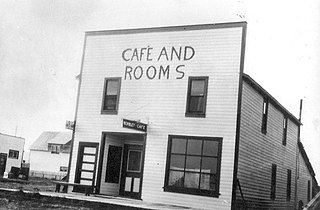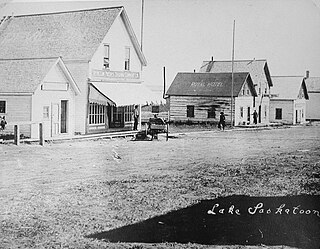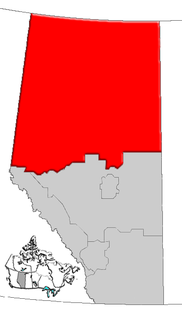
Wembley is a town in northern Alberta, Canada. It is located approximately 23 km (14 mi) west of Grande Prairie at the junction of Highway 43 and Highway 724. A resident of Wembley is known as a "Wemblian", or "Wembleyite".

Retlaw is an unincorporated community located in the Municipal District of Taber, Alberta, Canada. The community once had a peak population of over 250 citizens and was even incorporated under the status of a village until it was dissolved into a hamlet under the jurisdiction of Improvement District No. 96 on March 1, 1939. Retlaw is located 2 km (1 mi) west of Highway 864 6 km (3 mi) west of Vauxhall and 42 km (26 mi) northwest of Taber and 75 km (46 mi) southwest of Brooks.

Elmworth is a hamlet in northern Alberta, Canada within the County of Grande Prairie No. 1. It is located on Highway 722 north of the Wapiti River and east of the British Columbia border. It has an elevation of 715 metres (2,346 ft). The Elmworth natural gas field stretches west and south of the hamlet.

Albright, Alberta is an unincorporated locality within northwest Alberta, Canada within the County of Grande Prairie No. 1. It is located on Highway 43 and the Grande Prairie-Grande Cache Railway between Beaverlodge and Hythe. It has an elevation 740 meters (2,430 ft).

Rio Grande is an unincorporated community in northern Alberta within the County of Grande Prairie No. 1, located 32 kilometres (20 mi) southwest of Highway 43, 65 kilometres (40 mi) west of Grande Prairie.

Sylvester is an unincorporated community in northern Alberta within the County of Grande Prairie No. 1, located 41 kilometres (25 mi) southwest of Highway 43, 75 kilometres (47 mi) west of Grande Prairie.
The locality of Halcourt, about 40 km west of Grande Prairie, was named after Harry Halcourt Walker, an early settler who filed claim in April 1910 as the land was being surveyed for settlement. The first public building was the Halcourt Methodist Church, which opened in 1911. In 1912, Halcourt School District 2835 was formed and classes held in the church until a log school was built kitty-corner from the church in 1914. On May 15, 1913, a post office was established in Thomas Metcalf’s home across the road east of the school on Section 33, township 70, range 10, west of the 6th meridian. This was the center of the community until 1917, when the school was moved two miles west to the intersection of ranges 10 and 11, and townships 70 and 71. This was where the community grew, with the addition of Funnell’s Store, the District Nurse’s Cottage, and Frank Keasis’ blacksmith shop in 1922. About the same time, a cemetery was laid out a half mile south of the church. In 1924, the Orangemen’s Hall was built across the road from the school, and in 1938 a Curling Rink beside the hall. During the 1930s the residents created a Sports Ground two miles south on the banks of the Red Willow River. The community also boasted a tennis court, a Literary Society, and Funnell’s Orchestra. After 45 years of operation, the school closed in 1957, but the building was retained as a hall operated by the Halcourt Ladies Club. The post office closed in 1962. (4) Today, the historic church and school, as well as the active cemetery mark the locality of Halcourt.
The locality of Hayfield was also known as Leighmore, approximately 52 km west of Grande Prairie, formed around the Leighmore Post Office established July 1, 1922 in the home of George James Beadle on the SW quarter of section 10, township 71, range 11, west of the 6th meridian. According to Place Names of Alberta. Volume IV. Northern Alberta, it was named after post master Beadle’s former home in the Channel Islands, the Barnardo Boys Home at Teighmore Park on the Island of Jersey. The name was misspelled, and recorded as Leighmore. In 1934, Hayfield School District 4661 was formed for the children of the area, as their former schools at Appleton and Rio Grande were becoming overcrowded. The post office closed in 1947, and the school in 1950. Information on people who lived in the Leighmore district can be found in Beaverlodge to the Rockies.
The locality of Hinton Trail, about 40 km south-west of Grande Prairie, developed at the north end of the Hinton Trail which ran from Jasper to Hinton, and then on to "the grande prairie". From Hinton, the trail followed Nose Creek north up to the Wapiti River, crossing it and heading overland to the Redwillow River about a half mile west of where the first Hinton Trail Post Office was set up in the home of Stan Ronksley on the NW quarter of section 5, township 70, range 10, west of the 6th meridian. The Ronksley home was across from Craigellachie School, a one-room log school built in 1922. The school also served as the community gathering place until the Hinton Trail Hall was built in 1947. The school closed in 1948, and the post office in 1968. The Hinton Trail Hall and a marker showing where the Hinton Trail crossed through the area about ½ mile east of the hall still mark this locality. Information on the people who lived in the Hinton Trail district can be found in Beaverlodge to the Rockies and its Supplement.
The locality of Homestead, located approximately 48 km north-west of Grande Prairie, formed around the Homestead Post Office, established November 1, 1930. The post office was in the home of Christian & Caroline Nordhagen, who also operated a small store. The land in that area had been opened for homesteading in 1929. A forest fire had ravaged the area, leaving a fine white ash over the land, so when the school district was established in 1930, it was named Ashdown. A log school was built on the NW quarter of section 20, township 75, range 9, west of the 6th meridian. This was the community centre for club meetings, concerts, dances and church services until 1949, when the Northern Lights Hall was built. The school closed in 1956 and the post office in 1962. The vacant school was used as a United Church until it was sold in 1959, but in 2006, the Ashdown Historic Society was formed to preserve the site and the building.
The locality of Mount Valley, approximately 54 km south-west of Grande Prairie, centered on the Mount Valley Store which was established by Colonel Lyle and Cephas Tennyson of Beaverlodge ca. 1930. The name is descriptive, as the location of the store was in a valley near the mountains. It was located on Ed Moore’s homestead, the NE quarter of section 25, township 70, range 13, west of the 6th meridian. In January 1932, West End School District 4592 was organized and a log school on a stone foundation was built two miles west of the store on the NW quarter of section 23. On January 8, 1938, the Mount Valley Post Office was added to the store, now owned by the Elliott family. The postmistress was Mrs. Elva Elliott Lingrell, a daughter of the family. Although the school only lasted a few years, closing in 1935, the store and post office operated until the building burned down in 1951. The closing date for the post office is recorded as September 16, 1951.
The locality of Windsor Creek, Alberta is c. 72 kilometres (45 mi) west south-west of Grande Prairie. Named for its proximity to the creek of the same name, it has a post office dating to October 1929.

Hazelmere is an unincorporated locality in northwest Alberta within the County of Grande Prairie No. 1. It is located between the Red Willow River and Diamond Dick Creek, approximately 75 km (47 mi) southwest of Grande Prairie.

Glen Leslie, Alberta is an unincorporated locality in northwest Alberta, Canada within the County of Grande Prairie No. 1. It is approximately 20 km (12 mi) east of Grande Prairie, south of Highway 43 on Highway 670.

Lake Saskatoon is an unincorporated locality in northwest Alberta, Canada within the County of Grande Prairie No. 1. It is located approximately 18 km (11 mi) northwest of Grande Prairie.
Brainard is an unincorporated locality in northwest Alberta within the County of Grande Prairie No. 1. It is located approximately 61 kilometers (38 mi) north-west of Grande Prairie, Alberta. The locality was originally established in 1919 and took the name of the first postmaster, Lee Brainard.
Bad Heart, Alberta, Canada is a small town in the County of Grande Prairie No. 1, approximately 50 km north-east of the town of Grande Prairie, Alberta.
Fitzsimmons is an unincorporated locality in northwest Alberta within the County of Grande Prairie No. 1. It is located approximately 30 km north-east of the City of Grande Prairie.

The locality of Webster, Alberta was established in 1916 as a station on the Edmonton, Dunvegan and British Columbia Railway, about 30 km north of the city of Grande Prairie. It was named after George Webster, a subcontractor for the railway at that time.











